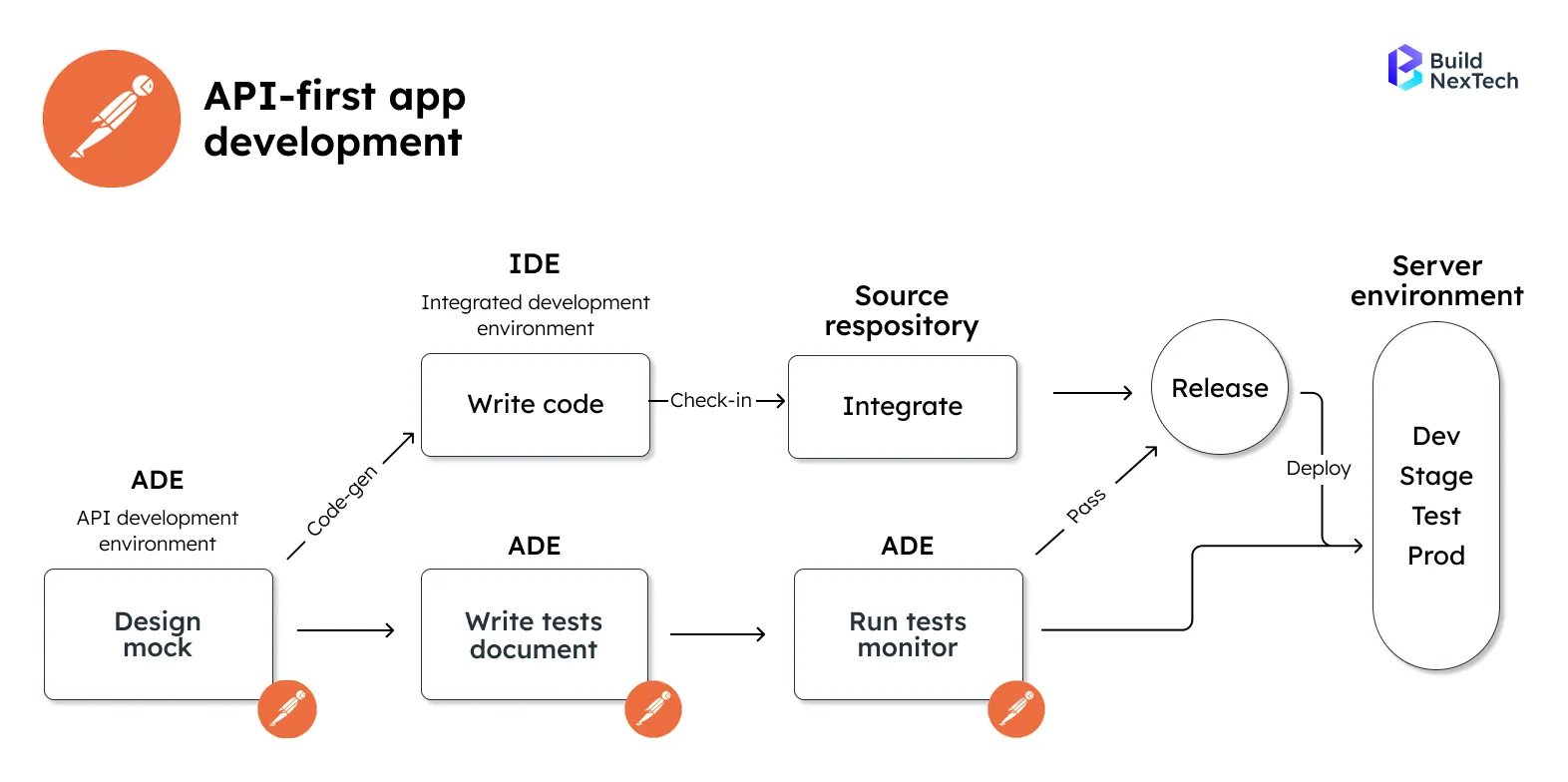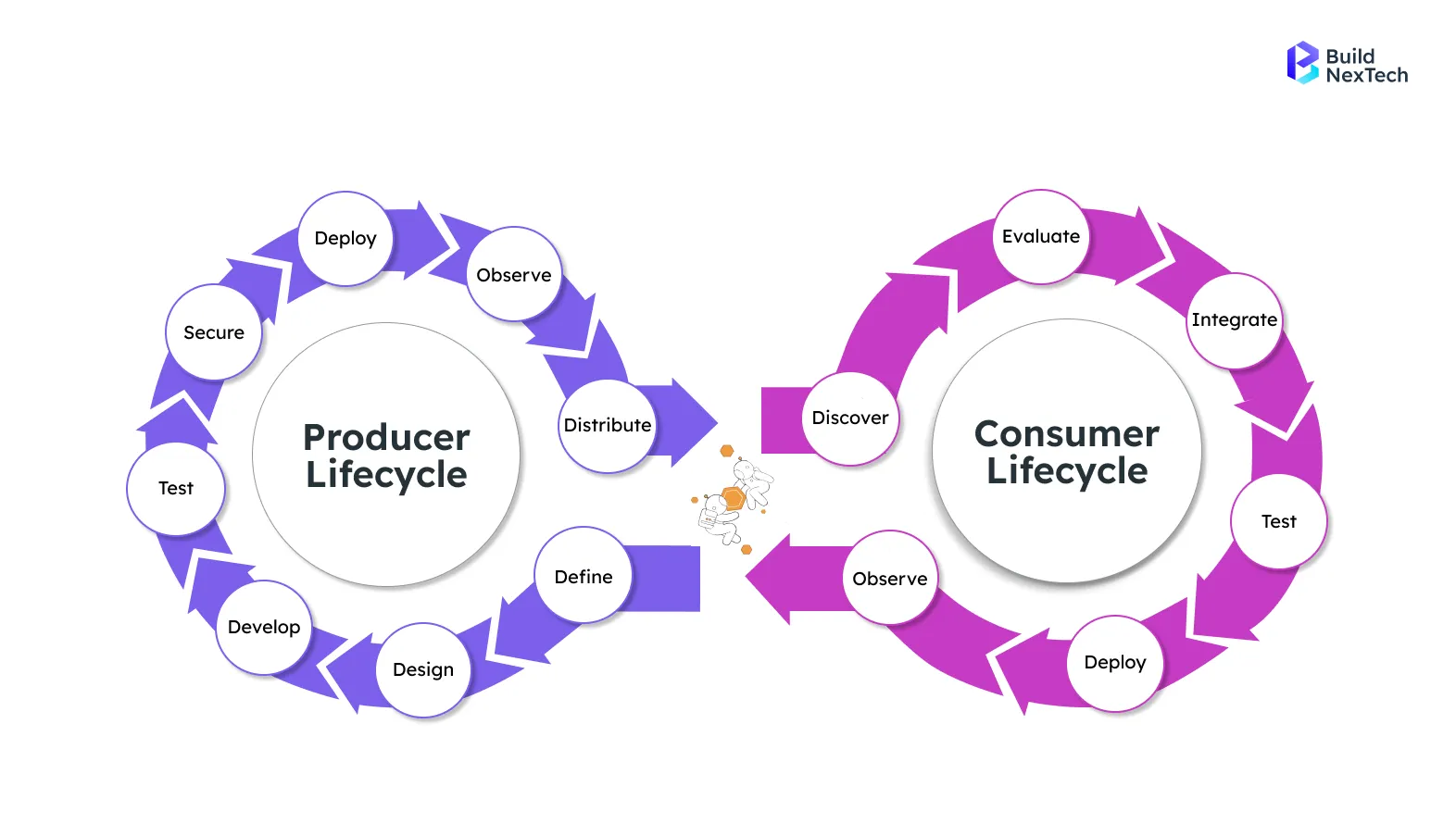API-First development has revolutionized the way software applications are created, emphasizing the creation of robust, scalable APIs before building the front-end or back-end services. In 2025, the API-First development approach is gaining momentum, driving businesses toward more agile, scalable, and efficient systems. Companies like BuildNexTech leverage API-first strategies to provide seamless backend services and enhance integration across applications. This comprehensive guide explains everything you need to know about API-First development and its impact on modern software architecture, helping businesses achieve faster time to market and improved scalability.
What Is API-First Development? Understanding the Core Approach
At its core, API-First development is a strategy that prioritizes the design and development of application programming interfaces (APIs) before any other aspect of the software. Unlike traditional methods where APIs are created after the back-end or front-end components, API-First ensures that APIs are the foundational element of the application’s architecture.
Key Characteristics of API-First Development:
- Centralized API Design: API specifications are defined upfront, allowing all development teams (front-end, back-end, and mobile) to work concurrently with a clear, centralized contract.
- Collaborative Approach: The development process fosters collaboration across development teams, ensuring that all parts of the system align with the core API structure.
- Reusable APIs: APIs are designed to be modular and reusable, reducing development cycles and promoting consistency across applications.

By implementing an API-first strategy, organizations can create software that is easier to scale, manage, and maintain, significantly improving the development process.
The Benefits of API-First Development for Modern Software Solutions
API-First development offers several benefits for modern software applications, especially for organizations seeking to deliver robust, scalable, and secure systems.
Key Benefits:
- Improved Collaboration: By focusing on API design upfront, development teams can collaborate effectively across different layers (front-end, back-end, mobile, etc.), improving overall productivity.
- Faster Time to Market: With APIs defined early, teams can start working in parallel, cutting down development time.
- Scalability and Flexibility: API-first design allows businesses to build modular systems that are scalable, easy to update, and adapt to new technologies.
- Seamless Integration: APIs enable seamless integration with third-party systems and services, expanding the ecosystem and improving functionality without disrupting the core application.
API-First vs Traditional Development: Why API-First is the Future
When comparing API-First development with traditional methods, there are clear distinctions in approach and benefits.
Traditional Development Approach:
- APIs are often created after the back-end or front-end systems are developed.
- Changes to APIs can require significant rework in other parts of the application.
- Collaboration between teams may be more siloed, leading to inefficiencies.
API-First Development Approach:
- The API is designed upfront, aligning the development process from the start.
- Changes to the API don’t require major changes to the front-end or back-end systems as long as the API contract remains intact.
- Parallel development becomes possible, where teams can work on separate components without waiting on each other.
In today’s fast-paced environment, API-first development is the future of building robust applications due to its flexibility, speed, and scalability.
How Custom API Development Services Enable Seamless API-First Implementations
Custom API development services allow businesses to tailor their API architecture to meet specific requirements, ensuring that the APIs are optimized for their unique needs. These services support businesses in adopting API-first development by creating custom-designed APIs that ensure seamless integration with other systems.
Advantages of Custom API Development:
- Tailored Functionality: APIs are designed specifically for the business logic of the application, ensuring optimized performance.
- Better Security: Custom APIs can implement unique authentication methods like Token-based authentication to protect sensitive data.
- Flexible Integration: Custom APIs enable seamless integration with third-party services, ensuring that all parts of the system work cohesively.
Building Scalable Systems with API-First Design and Architecture
One of the most significant advantages of API-first design is the ability to build scalable systems. By prioritizing API design, developers ensure that systems can easily handle future growth, whether in terms of users, features, or data volume.
How API-First Design Supports Scalability:
- Modular Architecture: APIs are designed as independent services, allowing businesses to scale them as needed.
- Load Balancing and Fault Tolerance: With a well-designed API gateway, requests can be routed efficiently, ensuring that the system remains responsive under heavy load.
- Versioning Strategy: Proper API versioning ensures that new versions of the system don’t break compatibility with older versions, allowing gradual scaling without disrupting the user experience.
How API Development and Integration Drive Success in API-First Ecosystems
API development and integration play a critical role in ensuring the success of an API-first ecosystem. A well-integrated system can improve collaboration across teams, reduce the likelihood of bugs, and create smoother workflows.
Role of API Development and Integration:
- Efficient Collaboration: By defining APIs first, teams can easily integrate their work into the overall system.
- Automated Testing: Automated API testing ensures that every interaction within the ecosystem functions as expected.
- Real-Time Updates: With real-time updates, businesses can provide dynamic and up-to-date functionality to their users, enhancing the user experience.
Connecting Your Systems with API Integration Services in an API-First World
API integration services are essential for ensuring seamless communication between different systems and third-party services. Whether it's connecting a back-end service to a mobile app or integrating with external tools, API-first development provides the foundation for these integrations.
API Integration Services Enable:
- Data Exchange: API integrations ensure that data flows seamlessly between systems, enabling synchronized operations.
- Third-Party Service Integration: Easily connect with external APIs, such as payment gateways, authentication providers, and analytics services.
- Consistency Across Platforms: With well-designed APIs, you ensure consistent response formats across different platforms, improving the overall experience for users.
Essential Tools for API-First Development: API Management Platforms
For successful API-first development, having the right tools is essential. API management platforms provide the necessary infrastructure to design, deploy, monitor, and secure APIs efficiently.
Key Features of API Management Platforms:
- Centralized API Gateway: Manage all your APIs from a single point, simplifying routing and load balancing.
- API Documentation: Automatically generate interactive documentation to help developers understand how to interact with your APIs.
- Security Features: Implement authentication, authorization, and installment restriction mechanisms to protect APIs.
Essential Tools for API-First Development:
- Apigee: A Google Cloud service offering full API lifecycle management, including API design, security, and analytics.
- AWS API Gateway: Provides tools to create, publish, and manage secure APIs at any scale, integrated seamlessly with AWS Lambda and other AWS services.
- Kong: An open-source API management platform designed to scale with a focus on high performance, ideal for managing microservices.
- Postman: While not a full API management platform, Postman simplifies API development and testing, providing easy integration with CI/CD pipelines.
- MuleSoft: An enterprise-level API management platform that includes a complete suite for API design, monitoring, and analytics, making it ideal for large organizations.
These tools collectively help manage API traffic, ensure security, and facilitate seamless integrations, enabling effective API-first architecture in modern application development.
Why API Management and Integration Are Crucial for API-First Architectures
In an API-first architecture, managing and integrating APIs efficiently is crucial for system longevity and scalability. Without proper management, APIs can quickly become a bottleneck that impacts performance and security.

Importance of API Management and Integration:
- Security Management: Tools like API gateways and OAuth authentication ensure secure communication between services.
- Version Control: Proper versioning strategy helps manage multiple versions of APIs, ensuring compatibility across systems.
- Monitoring and Analytics: Track API usage, monitor performance, and optimize routes to ensure your API ecosystem runs smoothly.
Exploring Popular Backend Development Frameworks in an API-First Environment
Play a key role in creating the backbone of the first environment of the popular backend development framework API. These frameworks help developers build secure, efficient, and scalable APIs to serve as the foundation for applications in an API-first architecture. The right backend framework enhances API integration, ensuring the API architecture is both robust and adaptable.
Popular Frameworks for API Development:
- Node.js
Node.js is a fast, event-driven runtime that is ideal for building real-time applications. This JavaScript runtime environment is highly efficient, making it the go-to choice for developers who need to handle API requests and real-time updates. Its non-blocking nature allows for high performance in environments that require real-time interaction, such as chat applications and mobile applications. - Spring Boot
Spring Boot, a popular Java framework, is known for its scalability and seamless integration with APIs. It provides a robust, RESTful architecture, which simplifies the development of secure and scalable API-first applications. Spring Boot's modularity and flexibility make it suitable for building back-end services with clear API contracts, allowing for smooth integration between external applications and internal systems. - Django
Django, a Python-based framework, allows developers to rapidly build secure APIs with a focus on business logic. Its built-in features, like token-based authentication and support for interactive documentation, make it easy for developers to create well-designed APIs. Django ensures secure API interfaces and is known for its fast API development cycle.
How These Frameworks Support API-First Development:
- Modular Development: Frameworks like Node.js and Django encourage modular API development, allowing backend developers to create independent API endpoints that can be easily maintained and updated.
- Security: By leveraging authentication methods such as OAuth and Token-based authentication, these frameworks ensure that APIs remain secure from external threats and unauthorized access.
- Versioning Strategy: Each framework supports an API versioning strategy, which is critical for ensuring backward compatibility when updates or changes are made to the API-first development model. This allows teams to manage the evolution of API contracts smoothly.
- Seamless Integration: These frameworks enable seamless integration with third-party services, ensuring that data can flow freely across applications. By adhering to API-first methods, these frameworks foster better collaboration among teams and create a more efficient development process.
Key Features to Look for in Backend Frameworks:
- API Documentation: Comprehensive API documentation is essential in an API-first environment, providing developers with the necessary tools to understand and interact with APIs easily. All three frameworks offer built-in tools to automate and generate interactive documentation.
- Real-Time Communication: For applications that require real-time updates (e.g., live notifications or collaborative features), frameworks like Node.js offer a non-blocking architecture that supports high concurrent connections without performance degradation.
- Collaboration and Iteration: These frameworks facilitate iterative processes during development. They enable real-time updates and streamline development cycles, allowing teams to make quick changes to API requests and iterate on features based on user feedback.
By using these frameworks in an API-first strategy, development teams can significantly improve collaboration, reduce development time, and build more scalable, maintainable systems. These frameworks also provide the necessary infrastructure for managing API endpoints, ensuring consistent API responses and handling API status codes effectively.
The Future of API-First Development: Key Trends in API Management and Integration
As the demand for scalable and secure APIs increases, API-first development will continue to grow in importance. Below are key trends shaping the future of API management and integration:
- Increased Adoption of RESTful APIs
RESTful APIs will remain dominant due to their scalability and ease of integration with backend services and client applications. - API-First Becomes the Standard
Prioritizing API-first development ensures faster time to market and enhances collaboration between development teams by defining APIs upfront. This method is becoming the go-to approach for organizations looking to create scalable and flexible systems. - Automation and Continuous Integration
Automated testing and continuous integration will streamline API development, reducing errors and improving API documentation. This will accelerate the development cycle and make the process more efficient. - Enhanced API Security
As the volume of API interactions grows, stronger authentication methods, encryption, and API security measures will be essential. Businesses will increasingly rely on custom web development services that include robust API security features to protect data and prevent unauthorized access. - Microservices and Serverless Architectures
API-first development will support microservices and serverless architectures, promoting seamless integration and scalability. As businesses move towards more modular systems, APIs will serve as the backbone for efficient communication between services. - Versioning and API Documentation
Better API versioning strategies and interactive documentation will improve usability and collaboration for both internal developers and third-party services. This will ensure that the web development company delivers APIs that are consistent and easy to integrate across different platforms.
By embracing these key trends, BuildNexTech will continue to lead the charge in providing custom web development services that are scalable, secure, and efficient, helping businesses adapt to the rapidly evolving landscape of API-first development.
People Also Ask
Difference between API-First Development and API-Last Development?
API-First Development prioritizes designing APIs before other components, ensuring consistency and scalability. In contrast, API-Last Development creates APIs after the backend or frontend is built, potentially leading to integration challenges.
How does API-First Development improve collaboration between backend and frontend teams?
API-First ensures a shared contract between teams by defining APIs upfront, allowing backend and frontend teams to work in parallel with a clear understanding of data flow and functionality.
How do you implement an API-First strategy in a microservices architecture?
In a microservices architecture, implement API-First by designing APIs for each service before development, ensuring clear communication between services and enabling scalability, flexibility, and independent updates.
What role does API testing play in an API-First development approach?
API testing ensures that the APIs meet design specifications, work as intended, and handle edge cases, providing reliability and consistency in the application’s communication layer.


























.webp)
.webp)
.webp)

